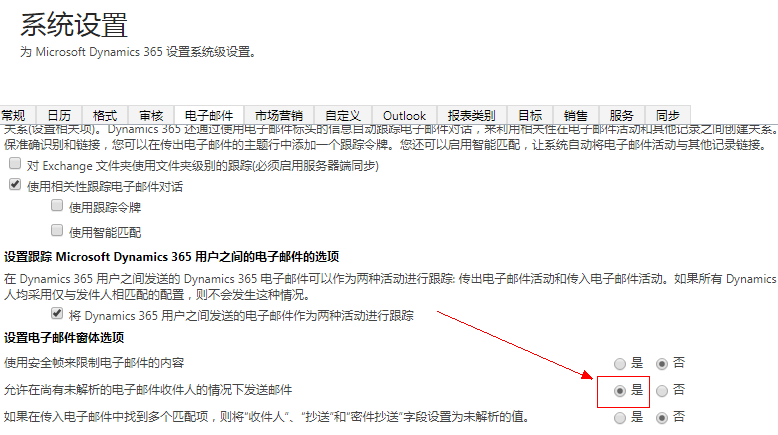摘要: 微软动态CRM专家罗勇 ,回复303或者20190213可方便获取本文,同时可以在第一间得到我发布的最新博文信息,follow me!我的网站是 www.luoyong.me 。
当然,首先要确认 【设置】> 【电子邮件配置】 > 【电子邮件配置设置】中的 【允许在尚有未解析的电子邮件收件人的情况下发送邮件】设置为是,还有就是连接CRM使用的用户邮箱已经配置好,外发邮件已经测试通了,可以发邮件。


不多说了,上代码:
using Microsoft.Crm.Sdk.Messages; using Microsoft.Xrm.Sdk; using Microsoft.Xrm.Sdk.Client; using Microsoft.Xrm.Sdk.Messages; using Microsoft.Xrm.Sdk.Metadata; using System; using System.Collections.Generic; using System.Configuration; using System.Net; using System.ServiceModel.Description; namespace SendEmailToEmailAddrs { class Program { static void Main(string[] args) { try { string inputKey; ServicePointManager.SecurityProtocol = SecurityProtocolType.Ssl3 | SecurityProtocolType.Tls | SecurityProtocolType.Tls11 | SecurityProtocolType.Tls12; IServiceManagement<IOrganizationService> orgServiceMgr = ServiceConfigurationFactory.CreateManagement<IOrganizationService>(new Uri(ConfigurationManager.AppSettings["orgUrl"])); AuthenticationCredentials orgAuCredentials = new AuthenticationCredentials(); orgAuCredentials.ClientCredentials.UserName.UserName = ConfigurationManager.AppSettings["userName"]; orgAuCredentials.ClientCredentials.UserName.Password = ConfigurationManager.AppSettings["passWord"]; string needConfirm = ConfigurationManager.AppSettings["needConfirm"]; using (var orgSvc = GetProxy<IOrganizationService, OrganizationServiceProxy>(orgServiceMgr, orgAuCredentials)) { WhoAmIRequest whoReq = new WhoAmIRequest(); var whoRsp = orgSvc.Execute(whoReq) as WhoAmIResponse; var userEntity = orgSvc.Retrieve("systemuser", whoRsp.UserId, new Microsoft.Xrm.Sdk.Query.ColumnSet("fullname")); Console.WriteLine(string.Format("欢迎【{0}】登陆到【{1}】", userEntity.GetAttributeValue<string>("fullname"), ConfigurationManager.AppSettings["orgUrl"])); Console.WriteLine("本程序用于向指定邮箱发送邮件!"); if (needConfirm == "Y") { Console.WriteLine("当前处于需要确认才会继续的模式,若要继续请输入Y然后回车确认!"); inputKey = Console.ReadLine(); if (inputKey.ToUpper() == "Y") { RetrieveAlternateKeys(orgSvc,whoRsp.UserId); } else { Console.WriteLine("你选择了取消运行!"); } } else { RetrieveAlternateKeys(orgSvc,whoRsp.UserId); } } Console.Write("程序运行完成,按任意键退出." + DateTime.Now.ToString()); Console.ReadLine(); } catch (Exception ex) { Console.WriteLine("程序运行出错:" + ex.Message + ex.StackTrace); Console.ReadLine(); } } private static void RetrieveAlternateKeys(OrganizationServiceProxy orgSvc,Guid userId) { const string functionName = "用于向指定邮箱发送邮件"; var EmailAddrs = ConfigurationManager.AppSettings["EmailAddrs"]; if (string.IsNullOrEmpty(EmailAddrs)) { Console.WriteLine("收件邮箱列表为空!"); return; } Console.WriteLine(string.Format("开始 {0} - {1}", functionName, DateTime.Now.ToString())); try { Entity emailEntity = new Entity("email"); var newtoPartyList = new List<Entity>(); var fromEntity = new Entity("activityparty"); fromEntity["partyid"] = new EntityReference("systemuser", userId); emailEntity["from"] = new Entity[] { fromEntity }; foreach (var item in EmailAddrs.Split(';')) { var toEntity = new Entity("activityparty"); toEntity["paricipationtypemask"] = new OptionSetValue(2); toEntity["addressused"] = item; newtoPartyList.Add(toEntity); } emailEntity["to"] = newtoPartyList.ToArray(); emailEntity["subject"] = ConfigurationManager.AppSettings["subject"]; emailEntity["description"] = ConfigurationManager.AppSettings["description"]; //emailEntity["regardingobjectid"] = new EntityReference("systemuser", userid); Guid emailGuid = orgSvc.Create(emailEntity); Console.WriteLine(string.Format("创建的邮件ID是{0}", emailGuid)); SendEmailRequest sendEmailRequest = new SendEmailRequest { EmailId = emailGuid, TrackingToken = string.Empty, IssueSend = true }; orgSvc.Execute(sendEmailRequest); Console.WriteLine("执行发送邮件消息成功!"); } catch (Exception ex) { Console.WriteLine(string.Format("运行 {0} 出现异常:{1}", functionName, ex.Message + ex.StackTrace)); } Console.WriteLine(string.Format("结束 {0} - {1}", functionName, DateTime.Now.ToString())); Console.WriteLine("================================================"); } private static TProxy GetProxy<TService, TProxy>( IServiceManagement<TService> serviceManagement, AuthenticationCredentials authCredentials) where TService : class where TProxy : ServiceProxy<TService> { Type classType = typeof(TProxy); if (serviceManagement.AuthenticationType != AuthenticationProviderType.ActiveDirectory) { AuthenticationCredentials tokenCredentials = serviceManagement.Authenticate(authCredentials); return (TProxy)classType .GetConstructor(new Type[] { typeof(IServiceManagement<TService>), typeof(SecurityTokenResponse) }) .Invoke(new object[] { serviceManagement, tokenCredentials.SecurityTokenResponse }); } return (TProxy)classType .GetConstructor(new Type[] { typeof(IServiceManagement<TService>), typeof(ClientCredentials) }) .Invoke(new object[] { serviceManagement, authCredentials.ClientCredentials }); } } }